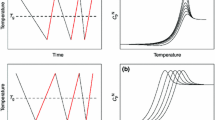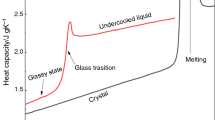Abstract
The so-called minimal model is formulated for describing the enthalpy relaxation and recovery in glass transition. The model is based on the Arrhenius law for the enthalpy relaxation, which uses two-dimensional parameters, namely the activation energy and the so-called pre-factor (relaxation time at relatively high temperature). A numerically effective exact analytical solution is obtained for the case of constant-rate differential scanning calorimetry. The developed model is analyzed according to the logic of the model itself without introducing additional simplifying assumptions of thermodynamic nature. For typical range of the model parameters, the resulting differential equation contains a large parameter, which offers an opportunity for the application of asymptotic and approximate techniques. A number of simple approximations have been provided for some thermodynamic quantities of interest.






Similar content being viewed by others
References
Hodge, I.M.: Enthalpy relaxation and recovery in amorphous materials. J. Non-Cryst. Solids 169(3), 211–266 (1994)
Seibert, H., Scheffer, T., Diebels, S.: Thermomechanical characterisation of cellular rubber. Contin. Mech. Thermodyn. 28(5), 1495–1509 (2016)
Leistner, C., Hartmann, S., Abliz, D., Ziegmann, G.: Modeling and simulation of the curing process of epoxy resins using finite elements. Contin. Mech. Thermodyn. 32, 327–350 (2020)
Angell, C.A.: Perspective on the glass transition. J. Phys. Chem. Solids 49(8), 863–871 (1988)
Scherer, G.W.: Theories of relaxation. J. Non-Cryst. Solids 123(1–3), 75–89 (1990)
Gutzow, I., Schmelzer, J.W.P., Petroff, B.: Phenomenological theories of glass transition: classical approaches, new solutions and perspectives. J. Non-Cryst. Solids 354(2–9), 311–324 (2008)
Bari, R., Simon, S.L.: Determination of the nonlinearity and activation energy parameters in the TNM model of structural recovery. J. Therm. Anal. Calorim. 131(1), 317–324 (2018)
Mauro, J.C., Mauro, Y.Z.: On the Prony series representation of stretched exponential relaxation. Physica A Stat. Mech. Appl. 506, 75–87 (2018)
Flügel, K., Hennig, R., Thommes, M.: Determination of the structural relaxation enthalpy using a mathematical approach. J. Pharmaceut. Sci. 108(11), 3675–3683 (2019)
Lion, A., Yagimli, B.: Differential scanning calorimetry-continuum mechanical considerations with focus to the polymerisation of adhesives. Zeitschrift für Angewandte Mathematik und Mechanik: Appl. Math. Mech. 88(5), 388–402 (2008)
Ferhoum, R., Aberkane, M., Ouali, M.O.: Distribution of nonliner relaxation (DNLR) approach of the annealing effects in semicristalline polymers: structure-property relation for high-density polyethylene (HDPE). Contin. Mech. Thermodyn. 26(3), 373–385 (2014)
Jennrich, R., Lion, A., Johlitz, M., Ernst, S., Dilger, K., Stammen, E.: Thermomechanical characterization and modeling of fast-curing polyurethane adhesives. Contin. Mech. Thermodyn. 32(2), 421–432 (2020)
Kovacs, A.J., Aklonis, J.J., Hutchinson, J.M., Ramos, A.R.: Isobaric volume and enthalpy recovery of glasses. II. A transparent multiparameter theory. J. Polym. Sci. Polym. Phys. Ed. 17(7), 1097–1162 (1979)
Tool, A.Q.: Relation between inelastic deformability and thermal expansion of glass in its annealing range. J. Am. Ceram. Soc. 29(9), 240–253 (1946)
Narayanaswamy, O.S.: A model of structural relaxation in glass. J. Am. Ceram. Soc. 54(10), 491–498 (1971)
Moynihan, C.T., Easteal, A.J., DeBolt, M.A., Tucker, J.: Analysis of structural relaxation in glass using rate heating data. J. Am. Ceram. Soc. 59, 12–16 (1976)
Fan, M., Zhang, K., Schroers, J., Shattuck, M.D., O’Hern, C.S.: Particle rearrangement and softening contributions to the nonlinear mechanical response of glasses. Phys. Rev. E 96(3), 032602 (2017)
Kohlrausch, R.: Theorie des elektrischen Rückstandes in der Leidener Flasche. Annalen der Physik 167(2), 179–214 (1854)
Williams, G., Watts, D.C.: Non-symmetrical dielectric relaxation behaviour arising from a simple empirical decay function. Trans. Faraday Soc. 66, 80–85 (1970)
Moynihan, C.T., Easteal, A.J., Wilder, J., Tucker, J.: Dependence of the glass transition temperature on heating and cooling rate. J. Phys. Chem. 78(26), 2673–2677 (1974)
Schmelzer, J.W.P., Tropin, T.V.: Dependence of the width of the glass transition interval on cooling and heating rates. J. Chem. Phys. 138(3), 034507 (2013)
Gutzow, I., Ilieva, D., Babalievski, F., Yamakov, V.: Thermodynamics and kinetics of the glass transition: A generic geometric approach. J. Chem. Phys. 112(24), 10941–10948 (2000)
Gutzow, I., Yamakov, V., Ilieva, D., Babalievski, Ph, Pye, L.D.: Generic phenomenological theory of vitrification. Glass Phys. Chem. 27(2), 148–159 (2001)
Volkenshtein, M.V., Ptitsyn, O.B.: The relaxation theory of glass transition. Dokl. Phys. 103(5), 795–798 (1955)
Vol’kenshtein, M.V., Ptitsyn, O.B.: Relaxation theory of vitrification. Solution of basic equation and its studying. Russ. J. Appl. Phys. 26(10), 2204–2222 (1956)
Sanditov, D.S., Ojovan, M.I.: Relaxation aspects of the liquid-glass transition. Physics-Uspekhi 62(2), 111 (2019)
Bragg, W.L., Williams, E.J.: The effect of thermal agitation on atomic arrangement in alloys. Proc. R. Soc. Lond. Ser. A 145(855), 699–730 (1934)
Wunderlich, B., Bodily, D.M., Kaplan, M.H.: Theory and measurements of the glass-transformation interval of polystyrene. J. Appl. Phys. 35(1), 95–102 (1964)
Fedoryuk, M.V.: Asymptotics: Integrals and Series (In Russian). Nauka, Moscow (1987)
Tropin, T.V., Schmelzer, J.W., Aksenov, V.L.: Modern aspects of the kinetic theory of glass transition. Physics-Uspekhi 59(1), 42 (2016)
Sanditov, D.S., Ojovan, M.I.: On relaxation nature of glass transition in amorphous materials. Physica B: Condensed Matter 523, 96–113 (2017)
Doyle, C.D.: Series approximations to the equation of thermogravimetric data. Nature 207(4994), 290 (1965)
Flynn, J.H., Wall, L.A.: General treatment of the thermogravimetry of polymers. J. Res. Natl. Bureau Stand. 70(6), 487–523 (1966)
Ozawa, T.: Kinetic analysis of derivative curves in thermal analysis. J. Therm. Anal. Calorim. 2(3), 301–324 (1970)
Acknowledgements
IA is grateful to the Biofilms center for the hospitality during his stay at the Malmö University, where this research was carried out.
The authors would like to express their gratitude to the Referee for the valuable comments and suggestions.
Author information
Authors and Affiliations
Corresponding author
Additional information
Communicated by Andreas Öchsner.
Publisher's Note
Springer Nature remains neutral with regard to jurisdictional claims in published maps and institutional affiliations.
Rights and permissions
About this article
Cite this article
Argatov, I., Kocherbitov, V. Analysis of the minimal model for the enthalpy relaxation and recovery in glass transition: application to constant-rate differential scanning calorimetry. Continuum Mech. Thermodyn. 33, 107–123 (2021). https://doi.org/10.1007/s00161-020-00891-3
Received:
Accepted:
Published:
Issue Date:
DOI: https://doi.org/10.1007/s00161-020-00891-3




